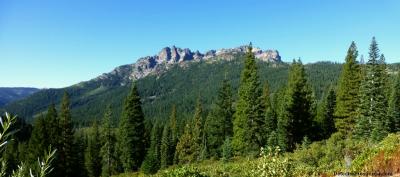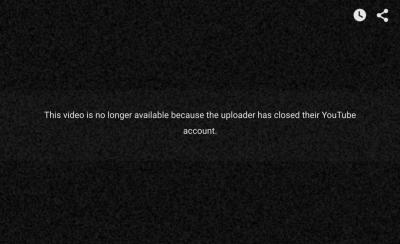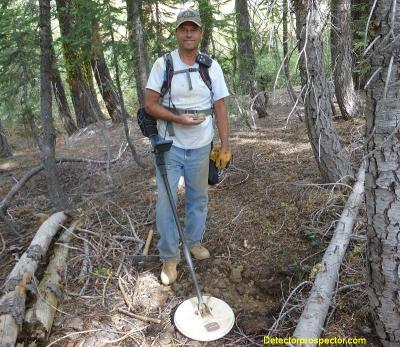-
Posts
19,757 -
Joined
Content Type
Forums
Detector Prospector Home
Detector Database
Downloads
Everything posted by Steve Herschbach
-
The consensus I have seen from experienced detectorists everywhere is that they prefer detecting in damp as opposed to bone dry ground. I generally share that preference but I think it can go either way from a straight up performance perspective. For instance compressed dry forest duff would normally be invisible to the detector, but when wet there may be enough tannin content to set up a weak conductive signal. Something a PI would probably miss but a hot VLF or GPZ??? I know large fern root wads will give off a signal when wet more than dry. The only issue I have had personally in the Sierras is that it seems no matter where you go even far off the beaten path there are tiny bits of steel flake and wire about. Most from old logging operations but some is like it just fell out of the sky. I can be in a spot where I would swear the only thing that could go beep is gold, and up comes a tiny bit of steel out of the duff. Very annoying. No matter what after a good rain the air is sweeter and the forest quieter. There are few places I have ever been as nice as the Sierra Mountains.
-
And all the videos along with it. Very odd to say the least. Some good content there, especially the videos by JP. Hopefully it all comes back to life, otherwise a good resource lost and a lot of broken links for me to fix!
-

Steve's Insanely Hot GPZ 7000 Settings
Steve Herschbach replied to Steve Herschbach's topic in Minelab Metal Detectors
It depends on the mineralization level Paul. JP said "unless the surface mineralisation is Minimal." The type of mineralization JP is referring to is far more common in Oz than in the U.S. I have been fine letting my coil ride on the ground. From the white paper at http://www.minelab.com/__files/f/266297/KBA_24-1%20ZVT%20Technology.pdf "SATURABLE SOILS In any of the above settings, it pays to swing the coil an inch or two above the ground surface if the soils are considered saturable (VRM). Saturable means that a detector ground balances well if the coil is raised and lowered down to about a few centimeters above the soil surface, and for the worst saturation, down to several centimeters, but not if the coil is swung up and down to a height lower than these saturation 'height thresholds' (e.g. Down to the soil surface). This is discussed if further detail below." In other words, it it ground balances fine down to ground level, no problem. And then farther below it goes on to provide more technical details: "In any of the above settings, it pays to swing the coil an inch or so above the soil surface if the soils are considered saturable (VRM). Saturable means that a detector ground balances well if the coil is raised and lowered down to about a few centimetres above the soil surface, and for the worst saturation, down to several centimetres, but not if the coil is swung up and down to a height lower than these saturation ‘height thresholds’ (e.g. down to the soil surface.) In addition, the degree of (VRM) soil saturation is considerably less for Difficult or Severe than Normal. As the metal detector coil is moved towards a soil, the transmitted magnetic field in the soil gets stronger. This causes a (very) small degree of VRM signal ‘saturation’ that happens to cause the resistive signal relative slope of the tilt to change. This is why the amount of VRM soil saturation is far less for Difficult and Severe than Normal. Soil saturation often requires the user to operate the coil several centimetres above the soil surface for best results." I posted in even more detail about this in May at http://www.detectorprospector.com/forum/topic/970-minelab-gpz-7000-a-super-vlf-saturable-soil-tips/ The detector will tell you what to do. If the ground is making noise, slow down or raise the coil, or both. -

Steve's Insanely Hot GPZ 7000 Settings
Steve Herschbach replied to Steve Herschbach's topic in Minelab Metal Detectors
JP just made a killer post on this subject on the Oz forum referenced earlier. Hopefully he will here - Great stuff! -

GPZ 7000 Control/Audio Problems
Steve Herschbach replied to Bada Bing's topic in Minelab Metal Detectors
I am going to refer this thread to Minelab. Bugs are always possible when software changes occur, and for obscure uses like dual wireless modules can get missed in testing. There is one way to test this, but it would be a hassle for you. You would have to reinstall the original firmware version and give it a go and see if problem repeats. If not that likely would be the issue, and if upon reinstalling the latest version of the firmware the problem occurred again, then that would pretty much nail it. And if that were the case I can almost guarantee it would get looked at by Minelab as bug and fixed in a future update. All still a bit of conjecture here but certainly a possibility. -

Steve's Insanely Hot GPZ 7000 Settings
Steve Herschbach replied to Steve Herschbach's topic in Minelab Metal Detectors
Nope. As I noted volume is one setting that may need tweaking. If 8 works better for you use 8. Hearing is funny stuff. I do not have good hearing. But I do have a finely tuned sense of audio change and what constitutes a target. I have always run audio settings on any detector I use quite low from a volume standpoint. All I need to be able to do is barely hear it, but I sure can pick up instantly on variations in what I am hearing. Or so it seems to me. How can I know what I am not hearing? Kind of like in Chris post. It is not necessarily that I do not hear the stuff that sounds like noise to him and drives him crazy. I just lower the level of the "noise" to where it is comfortable for me to listen to, and the noise goes in one ear and out the other - until that magical difference that indicates a signal. -

GPZ 7000 Control/Audio Problems
Steve Herschbach replied to Bada Bing's topic in Minelab Metal Detectors
Did you do the firmware update? And if you did, is this something that only started happening after the update? One of these days I will treat myself to another module. I like the idea of running two. -

GPZ 7000 Control/Audio Problems
Steve Herschbach replied to Bada Bing's topic in Minelab Metal Detectors
Some glitch in the GPZ then. I wonder how many people have run it with dual modules? Have you tried just a single module? Maybe the software gets confused when changing modes with dual modules. -

GPZ 7000 Control/Audio Problems
Steve Herschbach replied to Bada Bing's topic in Minelab Metal Detectors
So is it both modules that are losing the signal, or just one? -

GPZ 7000 Control/Audio Problems
Steve Herschbach replied to Bada Bing's topic in Minelab Metal Detectors
I have not had the problem but try resetting the WM12 itself. -
All it takes is money. Remote control, needs to move around, needs to dig. Mars Rover with metal detector. Me, I want to be doing it physically. The exercise is worth more than the gold.
-

GPZ New Quick Track Behavior
Steve Herschbach replied to hawkeye's topic in Detector Prospector Forum
JP is in a class all his own. There are many people on the forum as good or better than I at both metal detecting and prospecting. I just blab more and so am more visible. But thanks Fred for mentioning me in the same breath as JP - I am flattered! -

Steve's Insanely Hot GPZ 7000 Settings
Steve Herschbach replied to Steve Herschbach's topic in Minelab Metal Detectors
Paul, all it is was is a mention of his using Normal at http://golddetecting.4umer.net/t22791-more-than-40-deeper#220355 I had been mulling my post about running hot for some time and the fact Normal was working well for Dale triggered my post. Part of the problem we face prospecting is the differences between Oz and the US and stuff being posted in one place being misapplied in another. Dales post gave me confidence that the GPZ can be run hotter in Oz than I might previously have assumed and that therefore running hot might have wider application than I had thought. -

Gold Trails TV Show
Steve Herschbach replied to Sourdough Scott's topic in Detector Prospector Forum
Kevin has been around in the industry a long time, super knowledgeable, and just plain nice guy! -

Steve's Insanely Hot GPZ 7000 Settings
Steve Herschbach replied to Steve Herschbach's topic in Minelab Metal Detectors
Hello schiara, I have always run exclusively in ground tracking mode. It has always worked well for me, even before the recent update, and so I have seen no reason to use manual. I was a manual only guy until I got my hands on the SDC 2300, which is always tracking, and it is obvious it does not hurt its ability to get the faintest targets. With the confidence built there I just decided early on to go with the tracking system from day one on the GPZ and have never regretted it. JP made mentions about going to manual whenever digging targets but I have not. I do try and make sure my coil is well away from the hole and pick when I dig but I have not worried about it all that much. Seems if the pick was a problem then going over a can or big nails would be problematic also, and I sure go over my share of those with no seeming ill effects. Maybe I have been too lackadaisical in that regard. The good news is the update was designed to help with those sorts of things so it is doing nothing but get better. I am no electronics wizard but I do not see anything about the way the GPZ operates that would preclude discrimination being a feature we see some day. For now I seem to be able to cherry pick fairly well if I have to just by digging sweet tones. No doubt things get missed but in a field full of nails it is either do that or break out the VLF. -

Steve's Insanely Hot GPZ 7000 Settings
Steve Herschbach replied to Steve Herschbach's topic in Minelab Metal Detectors
Gold Hound, your post on the other forum inspired me to make my post here. Interesting on General and like all things just seems to depend on the ground. The ground I have been hunting as a rule is rather mild but sadly also rather shallow and gold not so large either. High Yield just seems to do the trick better here but then again it may just be my bad hearing does not allow me to equal you skill in that regard. I think I am a fairly good detectorist but never regarded myself as being top notch when it comes to getting my settings dialed perfectly. I rely on my prospecting skills and long hours to make up what I lack in tuning skills. I will try more with General however as I tend to get in a rut sometimes. Thanks for the tip. -

Steve's Insanely Hot GPZ 7000 Settings
Steve Herschbach replied to Steve Herschbach's topic in Minelab Metal Detectors
It's funny JP because I kind of assumed the same thing, but when I made the jump to 20 the machine just kept purring along. I should have gone there sooner like Ray. -

Steve's Insanely Hot GPZ 7000 Settings
Steve Herschbach replied to Steve Herschbach's topic in Minelab Metal Detectors
I agree Chris, it runs surprisingly well maxed out. You and Ray are making me feel better about posting it as sometimes I do just think I'm nuts. It is reassuring to know there are other hot rodders out there. Thanks! -

Steve's Insanely Hot GPZ 7000 Settings
Steve Herschbach replied to Steve Herschbach's topic in Minelab Metal Detectors
You are the perfect example of a truly knowledgeable VLF operator Ray so no surprises there. I think a good VLF guy like you has a far easier time learning a GPZ 7000 than somebody who has only used Minelab PI detectors. I am glad to hear the Zed is hitting a sweet spot for you. Really an amazing machine. I have to have Chris weigh my smallest piece as it is too small to accurately weigh even on my digital powder scales. He has some analytic scales. It was no accidental find while digging something else either. I used to walk away from some tiny gold signals with the Zed in early days but have my pinpointing down pat now, and it is crazy how small that big coil will hit. I have no doubt when a smaller coil comes out for the GPZ it will match or beat the SDC2300 on small gold. And as you know it gets the depth on the big stuff for sure. -

Steve's Insanely Hot GPZ 7000 Settings
Steve Herschbach replied to Steve Herschbach's topic in Minelab Metal Detectors
Norvic, I do have poor hearing and in fact wear hearing aids at times but not when I am detecting (they freak out) so who knows what other people hear compared to what I am hearing. No doubt some of this is to harsh for others and sounds fine to me? Again, that is why they give us controls to adjust. Even if we were all in the same location we all have personal differences to account for. -

Steve's Insanely Hot GPZ 7000 Settings
Steve Herschbach replied to Steve Herschbach's topic in Minelab Metal Detectors
Don't say I did not warn you. I don't keep close track of my hours but I know I have well over 500 hours on the GPZ and probably took me 300 hours of listening to the machine to get to where I am now. I have used those settings up in your neck of the woods though so it is not just a northern Nevada thing. If the andesite is not giving you good enough signals this will help! Some places, especially in Nevada these settings actually run pretty quiet. More than I let on really. Problem is I have nothing even hotter to run now so maybe Minelab needs to put in a special "Insane" setting just for me. It would probably make a person sterile running it but I don't want any more kids anyway. You must be headed for the foothills. Froze up solid over this way this morning. Good luck!! -

Dunno If This Is Real Or Not Or Where It Was Found?
Steve Herschbach replied to tvanwho's topic in Detector Prospector Forum
Not sure why you posted then went oops and deleted Tom but I restored the link, very interesting. Oh it is real all right, and spectacular stuff for sure. Africa probably, where else do people hack on fabulously valuable specimens with a hatchet! https://www.facebook.com/DetectoresDeMetalesMasterDetector/videos/915348648547946/ -
I have been holding off posting this, as I worry it could get people who do it into trouble, or cause people running the way I do to blame my settings on the GPZ itself. Reality is what it is however and my journey with the GPZ 7000 has taken me to interesting extremes. I decided it is time to just tell you what I have been using for settings and let the cards fall where they may. My early posts on the Zed all advised taking it easy with the settings early on, especially for beginners. I took my own advice and slowly ramped things up over time. The entire time however I have been going in just the opposite direction from where I headed with the Minelab PI detectors. The goal with the GPX 5000 and its predecessors was to seek the smoothest, quietest threshold possible. Every advance the units made moved in that direction, until with the GPX we reached the pinnacle of smooth, well behaved performance. The GPZ 7000 experience for me has been more like a return to my roots running hot VLF detectors. Most common and very sensible advice including that I have offered myself always has been about trying to get the machines to obtain a smooth steady threshold if possible. And good advice it is. The funny thing is, I usually never run my machines like that myself. I crank them up and run them hot and noisy. A novice listening to me run a Gold Bug 2 in bad ground would be baffled by all the sounds the machine is making. To me however after decades of detecting it is all just feedback about what is going on under the coil, with the key thing being that the magic sound of a real target just jumps out at me out of all the ground and hot rock sounds. The first thing I did with my GPZ 7000 was pay close attention to every tidbit Jonathan Porter would reveal. Two things got my attention. First was his mention of how the Zed has a livelier response to the ground when in operation. The second was his obvious dislike for audio smoothing. The first thing I did was turn audio smoothing off and I have basically never used it. The second step was in determining that in most ground I worked the Normal ground setting was far more powerful than the default Difficult setting. I used Difficult a bit initially, and fell back to it a few times, but going to Normal was something that happened very early on, and if you look at my earliest posts on the GPZ 7000 I advised people to always at least give Normal a try before going back to Difficult if need be. High Yield is the default GPZ gold mode and I have always stayed with it. Minelabs unfortunate naming of the gold modes make people think the other modes are deeper but they only are so in a relative sense, relative to the ground you are in and the gold you are hunting. More details on this thread at http://www.detectorprospector.com/forum/topic/1236-gpz-high-yield-general-or-extra-deep/ High Yield is the high frequency mode on the GPZ with the transmitted field switching pole directions three times faster than in General or Extra Deep. You could say there really are only two modes because General and Extra Deep are just two versions of the same mode. Yes, yes, yes, before people chime in, I am very aware there are times and places for General and even Extra Deep. In fact, I will always downshift to General before I will come off the Normal ground setting. For me default mode is Normal/High Yield and if things get difficult then go to Normal/General. The next shift down would be to Difficult/High Yield and then finally Difficult/General. I doubt I will ever use Extra Deep until a larger coil is on my GPZ. And even then not much. The last step was the Gain. I ran 12 a long time, then 14. Then two months ago I just jumped to 20. The GPZ the way I run is almost always making some kind of noise, all of which lumped together is what I use as a threshold sound. I control things mostly through three audio settings. To preserve my sanity I keep settings low. I never use headphones these days unless the wind is really bad, other wise I keep the wireless module on my upper left chest closer to my better ear. One oddity on the GPZ 7000 is that there really is not a basic volume control so you have to fiddle with several settings to get comfortable sound levels. What they call Volume on the GPZ 7000 should have been called Audio Boost. From the owners manual" "Volume controls the amplification of a target’s audio response, relative to the target signal strength. This audio setting is most similar to volume adjustments in other devices (e.g. radio or television volume controls). The Volume control has a range from 1 to 20 with a default setting of 8. With a setting of 1, weak target signals will sound quiet, medium target signals will sound mid-range and strong target signals will sound loud. There will be greater differentiation between target signal strengths; however, weak signals will be harder to hear. With a setting of 20, all target signals will be amplified to a loud audio response. At this setting there may be less differentiation between medium and strong signals, but weak target signals will be easier to hear." That last note might make you think more volume is better - you do not want to miss those weak signals! I tend the other way as I want my targets to exhibit as much audio variation as possible. This is one setting I still need to possibly tweak but for now I seem to have settled into 4 as the one that works best for my ear. Volume Limit is much more like a regular volume control. I would have put Volume Limit on the main settings page, then relabled Volume as Audio Boost and put it on the secondary page. Future update hint Minelab? Again, from the manual: "The Volume Limit sets the maximum volume for target signals. When detecting, the sound produced by a target can be very loud. Adjust the Volume Limit to ensure that loud targets do not hurt your ears. The Volume Limit has a range of 1-20, with a preset of 12." More like a blast limiter than a volume control but this control is the one you really need to use to control how loud the GPZ is. I find 12 to be way too high for me, and by coincidence 4 turned out to also work for me there. The final piece of the puzzle is the actual threshold setting. I find 22 works well for me when I am in very quiet locations, and I bump to 25 if there is noise from wind or whatever around me. There are other audio settings but I try to mess with as little as possible to keep changes simple if I do a master reset. On full reset I: Main Settings (Detect) Page 1. Switch from default Difficult ground setting to Normal 2. Sensitivity from default 9 to 20 3. Volume (Audio Boost) from default 8 to 4 Next Page - Detect Plus 4. Threshold from default 27 to 22-25 depending 5. Volume Limit from default 12 to 4 6. Audio Smoothing Off Next page - Settings 7. GPS from default off to Enhanced 8. Wireless from default Off to On 9. Connect to WM12 wireless module 10. Finally, go to Map Menu under View and turn View Geotrail from Default off to On Only after all this is done do I go through the Quick Start frequency scan and ground balance (with ferrite). These settings all will be retained with power off so done once and I am pretty well set. All I do from then on is fire up in morning and do the Quick Start routine, which I will repeat at lunch time or if I move to a new area. The only thing I have to really remind myself to do is when starting each hunt to go to the Create Geodata page to initiate saving my path to memory. If you are reading Minelab, why can't I assign this to the user button? And, if I forget and walk 1/4 mile before before doing it, it sure would be nice to be offered the option to pick up and save that last 1/4 mile, which is clearly there on screen and in memory, instead of losing it. But I digress....... Again, once all this gets set up it is retained on power off and repower, so for me I fire the GPZ 7000 up, do the Quick Start, go to Create Geodata, and start my hunt. The only setting I mess with may be the threshold, which I use as a sort of final audio sensitivity control. The secret to all this pretty much boils down to a hundred hours or more of using the GPZ to get used to the audio and the way the machine responds to the ground. In doing so it all becomes about coil control and sweep speed. When I run into ground noise, hot rocks, or other issues like salt ground, the only thing that normally changes is how fast I hunt. Everything quiet I go faster, more sounds I slow down. In salt ground I am moving at a crawl, letting the audio feedback dictate the sweep speed. I set up an artificial threshold of rising high tones and descending low tones by using a carefully controlled slow sweep. Even small nuggets still pop for me in salt ground. In other ground no matter what else is going on with these settings a nugget just goes "BANG"!! Chris Ralph and I hunt together a lot. He tried not even the full bore version of this, and immediately went back to his quieter settings. WARNING! I AM NOT RECOMMENDING THESE SETTINGS! All I am doing is telling you what I am doing. I am not saying they are the “best” settings or any such nonsense. They clearly will not work for many people and in many locations etc. etc. whatever. Running too hot can be counter productive. The happiest thing about the GPZ 7000 is in most cases it gets the gold if you get the coil over it using almost any settings. Chris certainly does as well as I using the settings he uses and he is happier for it. There are various “quiet” settings being used by others out there and they are finding lots of gold doing what they do. You do have to put the coil over the nugget first and foremost, and I am not going to be a settings snob and claim I know best for anyone besides myself. I have no doubt someday I will run into ground where I do something completely different. Always remember, there is never one magic setting for all times and places, otherwise all we would need is an on/off knob. Use what works for your ground and your own personal comfort level. But now at least nobody can say I did not tell you what settings I am using. Last warning though – getting a new GPZ 7000 and doing this would be like buying a new race car having never driven one, then getting in and just flooring it. You are going to crash and burn. If you are new to the GPZ, do please take it easy and give it time. It is one of those machines that really grows on you with time. Anyone giving up on it with under 50-100 hours really has not even tried. Or maybe GPX style hunting is just better for them. Just my opinion. Again, whatever works.
-

Gold Trails TV Show
Steve Herschbach replied to Sourdough Scott's topic in Detector Prospector Forum
No, in fact I have not seen the episode myself and I am not going to join the GPAA just to watch it. That one we met Kevin at Rye Patch a month ago. There is another one, from when we met Kevin at Gold Basin about a year ago. Never saw it either. Bummer. Thanks for posting Scott. I pretty much quit Facebook so I would not have seen the picture. And looking there I see that the good news is that some of the Gold Trails episodes are released on YouTube. -
Sounds like a good reason to drive down and do some Arizona nugget detecting!





